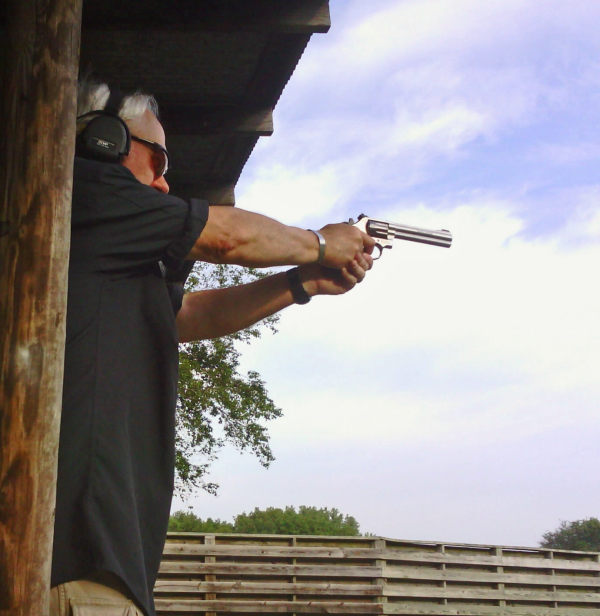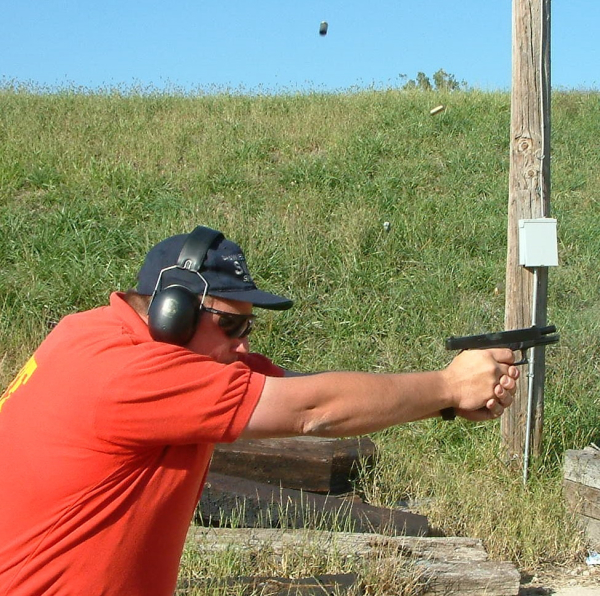
With the trigger finger loosely in the trigger guard of this Ruger LCP II 22 LR, the shooter waits until everything's right - then runs back against the trigger, firing the piece.
|
Of the fundamentals of shooting, trigger manipulation has traditionally not been as well covered as sight alignment/sight picture. Why?
We tend to be visual creatures, binocular vision, eyes on the same plane, better acuity (as a group) than we are at scent, for example. Also, handguns historically have sights made for . . . something other than accuracy. We’re trying to drill a hole through something that’s not within our immediate reach. To accomplish that, we have to line the “bit” up with the point to be drilled and hold it still while we commence the “bit” to start drilling.
But, it’s that “hold it still” thing that perplexes most of us. Sights are better today than ever in our history. Once we know where a student is looking and what he or she is seeing, we can chat about “seeing what you need to see and no more” – moving on to trigger. But even that doesn’t get it done, because a function of trigger control is grip – itself a critical aspect of the game.
How hard do you hang on to that pistol? An old timer told me to “hang on like your life depends on it – because it sure as hell does.” Beyond that your hand has to be high as possible on the gun consistent with allowing it to function (don’t have your hand under the travel of the exposed hammer, if equipped, or in the way of the slide).
All of that brings me to this. I had a T&E gun, the Ruger “Lite Rack” LCP II, and offered it to a young man who has some light acquaintance with shooting handguns. He’s a gun owner, has fired handguns, but he’s learning his way around them – as we all are.

I watched him instead of his target. I can learn more about how a shooter shoots and how well the shooter can hit by watching the process, not the target. The target will always be there to be examined later.
I quickly noted a hold low on the backstrap of the piece – and that’s not easy as there’s very little pistol there at all. I counseled a grip change first. Getting his hand higher, right under the tang, helped his hits immediately. Then I saw that his finger would be in the trigger guard, relaxed at the front of the space, until he decided the sights were good. Then that finger would come back and, in one stroke, fire the piece.
I’d seen that before; there’s a YouTube type who shoots a pistol just that way. Not revolvers, but semi-auto pistols. Before anyone speaks up, don’t mention high-speed pros like Rob Leatham. That’s a different category completely. The video personality referred to above will show his seven yard targets and 1 ½ - 2 ½ ” groups at that distance and pronounce satisfaction. For the way he handles that trigger, I can understand his acceptance.
And I’m not calling him out for derision either; he’s not stupid. In fact, I’d say he seems to be a good dude and someone who really knows stuff. It’s just the interaction with the trigger that grates.


So, noting that same syndrome here, I introduced “prepping the trigger.” Not useful for DA or SA revolvers, it’s the province of the semi-auto pistol, striker fired or single-action. When you have the muzzle coming onto the target, you can introduce your index finger to the face of the trigger. “Take the slack out,” as Jeff Cooper would say, until you hit the wall; there’s firm resistance.
Confirm the situation and continue the press. It’s like smashing a rotten grape under your finger against the face of the frame at the rear of the trigger guard. You’re compressing the back of the trigger into the trigger stop, letting the pistol fire. You can release to that wall, if you’re of a mind, or further during recoil. As the gun settles back into line, you can take that slack out and assess or shoot again. It depends. But always reset to fire again in case you must.
As he began these trigger control exercises – 22 LR is cheap – the groups tightened and confidence rose. That’s okay, all hopes will be dashed later, but learning occurred. I know the real hotshots are in too much of a hurry to approach shooting this way, but trigger control exercises are foundational and cumulative.
I demonstrated the double action revolver trigger on a Ruger LCRx; using the distal joint (‘power crease,’ thanks Mas!) and “rolling the trigger,” not pressing as before. It’s a different thing. But it’s the same too.
I also re-learned the value of video because I took cell phone video of a short string of fire he shot. I got to show him the muzzle “nose-dive” as he anticipated ignition – once. During the remaining string, the muzzle didn’t move at all as he pressed through.
Helping someone learn is relearning and valuable for personal improvement. I appreciate that help.
- - Rich Grassi